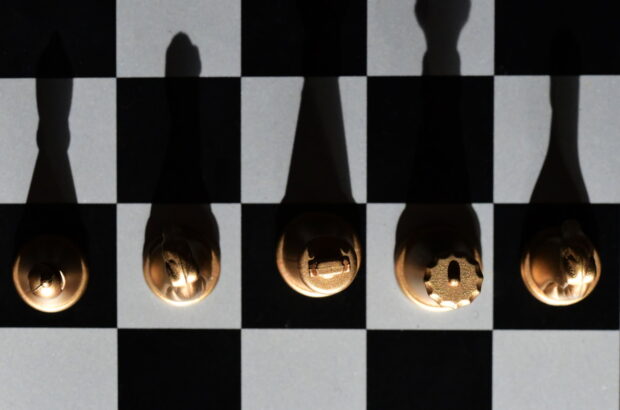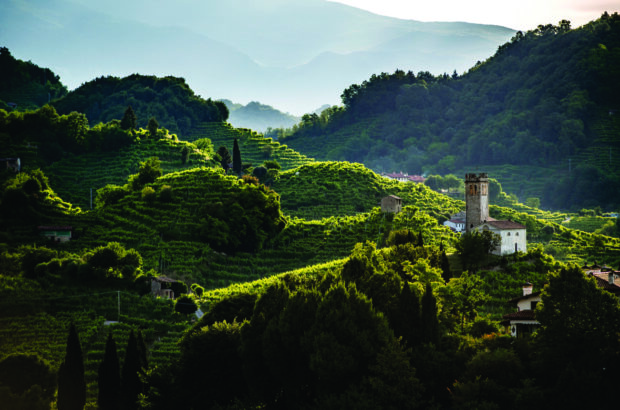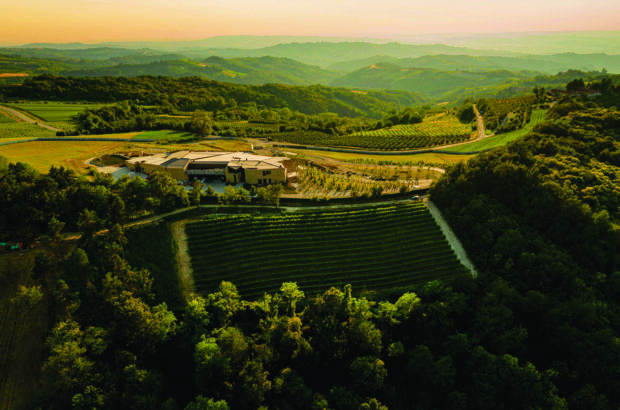It’s late October and Elena Fucci is about to begin the 2022 harvest. Her vines are planted at 600 metres above sea level in the volcanic soils of Monte Vulture in the Basilicata region and, despite being very far south – between Italy’s toe and heel – the nights are already chilly here.
‘I’m always the last to start picking my grapes,’ she says. ‘But for me, that’s an advantage: my six hectares of vineyards are planted to Aglianico, which is a late-ripening red variety, and that’s a big help in our increasingly hot summers.’
In July and August, instead of suffering too much heat stress, Aglianico shuts down its photosynthesis and the vines subsist on minimum energy until September, when the berries turn from green to red and resume ripening. ‘That stops the fruit from overcooking,’ Fucci explains. ‘The climate crisis is bringing an appreciation for late-ripening varieties – including Piedmont’s Nebbiolo and Umbria’s Sagrantino – for their ability to cope with changing growing conditions.’
A new push
Fucci, who was born in 1981, is at the epicentre of the ‘renaissance’ of the Aglianico grape in Basilicata. The region is one of Italy’s smallest, with just 580,000 inhabitants. The Aglianico del Vulture regional consorzio has 60 members, but only about 20 of these sell their wines abroad. Fucci is a member of Generazione Vulture, a group of eight of those wineries. They’re all run by young winemakers located around the extinct volcano, dedicated to revitalising the wines and image of this ancient indigenous variety.
While some of her co-members are children of winemakers or grew up around wine, Fucci is different. ‘I started from zero,’ she says. ‘I was a Coke-drinking student with little to no wine culture, though my grandfather did grow grapes to sell to the local cooperative.’
Her decision to run the estate was made in 2000 when her parents, both teachers, were debating whether to sell the land and the 16th-century casa colonica (‘farmhouse’) in Barile, in the heart of the DOC region, where she grew up. ‘I had just finished high school and had been considering a career in genetic engineering, but I felt I couldn’t let that sale happen. So I obtained a degree in oenology and agronomy in Pisa before coming back down here in 2005. My bond with this area was too strong to break.’
Fucci’s great-grandfather, Nicola Salvatore, had worked these vineyards as a labourer when they were part of a latifondo, the system of very large agricultural estates, usually owned by landlords living in the north, that was prevalent in the south of Italy until the 1950s. ‘Under the mid-century land reforms, my grandfather was able to buy these vineyards and 1.5 hectares of olive groves from the Tuscan landowner.’
Her parents were delighted with Fucci’s decision. ‘We cleared out the old cellar and got started,’ she recalls. ‘My first harvest produced just 1,200 bottles and I sold the rest of the grapes. Now, 17 years later, I’m producing 35,000 bottles per year.’ She also makes an extra-virgin olive oil.
Simple concept

Fucci’s winery and vineyard on the slopes of the extinct Monte Vulture volcano.
‘The volcano is 1,300 metres at its highest point and my land is in a single large piece about as far up as vines will grow,’ she explains. ‘It’s rare to have such a big vineyard on a mountainside, so my idea was very simple: I’d make one wine from one grape in one place – that is an easy concept to communicate.’
The vineyards are located in Contrada Solagna del Titolo, so she named her wine Titolo (‘title’). ‘Solagna means sun-facing, and the vineyard is like a big amphitheatre on lavic soils with a slight incline,’ she says.
Three hectares accommodate 60- to 70-year-old vines, while 1.5ha were replanted by her grandfather Generoso in 1998, and the remaining 1.5ha were planted in 2002. In 2020, Fucci bought an additional 1.5ha of vineyards nearby.
Fucci’s Titolo wines – Classico, Riserva, By Amphora and Pink – all stem from that one large vineyard, with Pink using its youngest grapes.
‘I’m a young woman and my wine has to be modern, not modernist,’ Fucci says. ‘I respect this grape and the unique terroir it comes from. That was not always the case here.’ As in Sicily, Puglia and other southern Italian regions, grapes in Basilicata were often sold to cooperatives or exported as bulk wine to secretly bolster the colour and alcohol levels of northern Italian and European wines.
‘Basilicata was no exception to this trade, and our approach to Aglianico suffered as a result,’ she continues. ‘We now realise that was a mistake. Aglianico is a very worthy grape to drink on its own when it’s handled properly.’ She says that, for her, the key is ‘to focus on obtaining perfect phenolic maturity in the vineyard’.
‘Science can help us to make better wines, and we do a lot of grape testing in the lab before the harvest. I’ve seen how things are done in France and northern Italy and have brought some of the solutions they favour down here, such as using a de-stemmer that leaves the berries whole, and an optical eye that can spot and reject unripe berries on the selection tables.’
Fresh interpretation
Fucci’s modern approach includes short macerations of about 15 days – unlike the months that Aglianico was left to macerate by previous generations. This keeps the fruit in her wines lively and fresh, and reduces the reductive and excessively tannic notes that are a characteristic of ‘traditional’ Aglianico. Grapes are pressed delicately after maceration, and she favours selected yeasts over spontaneous.
‘I’m more interested in maintaining traditions in the vineyard than in the cellar,’ she says. ‘We continue to harvest by hand, and I think there’s a truth behind the idea of planting vines close together to force their roots to go deeper.’ Fucci’s vines are planted at a density of 8,000-10,000 vines/ha. ‘We train our vines using the Guyot system, as is common here now, but we also have a group of old vines that use a much older system called a capanno,’ she explains. ‘It can be very time-consuming, as each freestanding vine requires three canes that need repositioning several times each season in relation to the sun and wind. But we want to keep this tradition alive, if only for didactic reasons.’
Fucci is also fully committed to the organic movement, and both her vineyards and cellar are certified. ‘It’s much harder to create a cellar that conforms to organic rules [compared with the vineyards],’ she says. ‘When I was planning my new cellar I didn’t set out to build what we call a bioarchitettura, but I encountered some architects who work this way. So the cellar was built primarily of recycled materials, like steel and wood from Vitalegno, and is cooled by rainwater and a system of wind-driven air pipes sandwiched within cavity walls that work like a Thermos. We use solar panels for energy, too. In Italy we are too tied to bricks; we should use more wood, which is also much better in seismic areas such as this.’ Her cellar is one of the first of its kind in southern Italy and she sees it as a long-term investment.
Scientific sense

Harvesting the Aglianico del Vulture grapes
Fucci favours French barrels: either 500-litre tonneaux or 200-litre barrels which are smaller than the usual barriques. ‘Three French coopers produce barrels to my specifications. I want to get the faster micro-oxygenation that is afforded by smaller barrels but with thicker staves to help slow that process down,’ she describes. ‘This allows the polyphenols to get a better and longer polymerisation, which results in more stable colour and tannins.’
Fucci’s scientific bent is clearly stimulated by the technical aspects of winemaking; she’s keen on experimenting, too. ‘I like to keep control of the wine production,’ she says. ‘When I saw wines being made in egg-shaped amphorae – produced in Impruneta, near Florence – I wanted to try Aglianico that way. I now use four of them and am pleased with the results. The wines are a little more concentrated and I’m fascinated by how the amphorae accentuate the minerality and saltiness of our volcanic soils.’
Fucci’s wines, which regularly score highly in tastings and win awards such as Gambero Rosso’s Tre Bicchieri, are distinctive both for their clarity and for their emphasis on the elegant fruit and freshness of this grape. The wine made in the neutral amphorae displays the natural spiciness and complexity of Aglianico when it’s not influenced by wood, and her rosé, too, explores yet another facet of this great Italian red grape.
What about the future for the region? ‘I’m optimistic,’ she says. ‘Basilicata’s wine movement is in full swing, and if we can support that with more high-level hotels to complement our great food, the area will become much better known. I often visit Tuscany with my husband. It’s such a “wow!” region and I always think: if they did it, why can’t we?’












